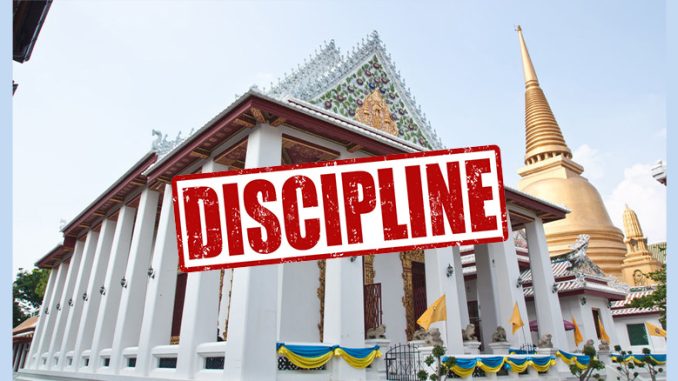
Be sure to fear the teacher, young one, his cane is sure and keen
Scared was I of its stinging strike once that pinching scythe I’d seen 1
(Sunthorn Phu, 1840-1842/2008: 85).
Being unregulated, punishment in the temple schools of 19th century Siam was highly dependent on the temperament of individual instructors. From temple to temple, wide variation in behavioral proscriptions and quality of instruction prevailed (McDaniel, 2008:85-6). Nevertheless, anecdotal evidence suggests a commonality; rural novities were subject to a much harsher regime of corporal punishment than their royal and noble brethren.
In an 1896 article, former novitiates Luang Prasoetaksoniti and Phraya Si Suthorn record that his local monastic school punished disrespect with the birch. At the commencement of study, a pupil thrice prostrates himself to his master, touching his head to the floor with each bow (Prasoet and Si Sunthorn, 1959: 47). The book from which he copies receives the same obeisance, as does his slate or blackboard, which must be bowed to before it is written upon and erased. If any books are inadvertently dropped or the pupil should leave or re-enter the area of study, the bow must be repeated. Three, five or, ten stokes of the cane are administered if these prostrations are neglected. Treading on or stepping over his or another’s blackboard, an act of grievous disrespect, also merits a flogging (ibid.)
A standard penalty of 3-10 strokes of the cane were administered for tomfoolery, pencil stealing, arguing, fighting, and spreading ‘evil’ gossip about a teacher (Prasoet and Si Sunthorn, 1959: 47). Offensive language in front of a teacher was prohibited, particularly talk of urine and feces while he dined. A practice known as son hai jam (สอนให้จำ – teaching to remember) advocated caning for mistakes in spelling or notation (MacFarland, 1884:209).
 For offenses deemed particularly disgraceful, children were ‘wildly beaten’ (ตีป่า), sometimes to the point of unconsciousness (Prasoet and Si Sunthorn, 1959:17). Others were struck so fiercely they appeared ‘possessed by demonic spirits’ (ibid). Elaborate punishments were common. Recalcitrant students were suspended by bound hands and had their bare backs beaten; a ‘torture to banish laziness’ and ‘break the spirit’ (Prasoet and Si Sunthorn, 1959:51). A variation of this was to bind a pupil’s hands behind a post where he could be whipped ‘two or three dozen [times], as the case seems to require’ (MacFarland, 1884:209). Such punishment, however, was not universal. A pupil in a temple school after the reforms of 1902, remembers teachers who frequently joked with students and were content with little more than a slap of the wooden ruler. One monk insisted his pupils massage him in lieu of physical punishment (Kumut, 1940:73) 2
For offenses deemed particularly disgraceful, children were ‘wildly beaten’ (ตีป่า), sometimes to the point of unconsciousness (Prasoet and Si Sunthorn, 1959:17). Others were struck so fiercely they appeared ‘possessed by demonic spirits’ (ibid). Elaborate punishments were common. Recalcitrant students were suspended by bound hands and had their bare backs beaten; a ‘torture to banish laziness’ and ‘break the spirit’ (Prasoet and Si Sunthorn, 1959:51). A variation of this was to bind a pupil’s hands behind a post where he could be whipped ‘two or three dozen [times], as the case seems to require’ (MacFarland, 1884:209). Such punishment, however, was not universal. A pupil in a temple school after the reforms of 1902, remembers teachers who frequently joked with students and were content with little more than a slap of the wooden ruler. One monk insisted his pupils massage him in lieu of physical punishment (Kumut, 1940:73) 2
Parents and guardians were aware of such punishment and seldom objected. On the contrary, some appealed for harsher penalties. A foreign observer noted that parents presenting their boy for tuition implored the monk to ‘whip him a great deal; do not break his back or put out his eyes; anything less than that you can do and I won’t say a word’ (MacFarland: 1884:209). Many parents left their child at a temple some five or six hours walking distance from their house to ensure he could not return to help them in the fields and thus incur the wrath of his teacher (Prasoet and Si Sunthorn, 1959).
Noble sons were more indulged than their parochial brethren. Their novitiates were undertaken in one of the capital’s royal monasteries, for the period of around a year following the tonsure ceremony of pre-pubescence. Still bound to the same ten precepts and obliged to honour and serve their master faithfully, titled novices nevertheless escaped the onerous chores and harsh punishment that were the lot of less illustrious neophytes (see Wyatt, 1969:11). During his novitiate at Wat Bowonniwet in 1875, Prince Damrong was tasked with little more than delivering his master’s morning toothbrush and spitoon, a commission undertook for a week before the obligation was considered fulfilled (Damrong, 1946:241). After completing his daily almsround, the thirteen-year-old wandered the city before returning to temple for evening sermons. Occasionally, he amused himself playing fireworks with older friends in the Royal Pages Corps stationed nearby.
Damrong memoirs give no account of novitiary discipline at Bowonniwet. However, an incident occuring some three years prior to his ordination indicates his ignorance of corporal punishment. Studying in the Royal Pages School, Damrong records his distress when admonished by his British teacher Francis George Petterson.
Although I adored studying English, far more than the Bahir script, I did not wholly escape misfortune at the school, for I was unfamiliar with the mode of discipline. Not two or three days into my studies, the teacher caught me mischievously tormenting my fellow classmates and subjected me to a farang punishment. He bade me stand fifteen minutes atop a chair placed, humiliatingly, at the corner of the room (no doubt the first such instance of a Thai child receiving this penalty). Seeing the bizarre spectacle, the other students stared at me fixedly, as if from a single eye. Some smiled and tittered as tortuous beads of sweat marked my disgrace. I never misbehaved in class again, though I felt stigmatised (อัปยศ) for many days, until the teacher slapped the palms of two other boys with a wooden rule. Witnessing this far crueller remonstration subsided my irritation completely.
Damrong, 1946:203
The teachers at the Royal Pages School, where entrance was restricted to the elite, were discouraged from applying physical punishment. When the school opened, a notice in the Royal Gazette (J.S. 1236 [1874]:257) assured the extended royal family that teachers were ‘paid an appropriate salary’ and taught ‘with a pleasant deportment with no dispensation to scold, strike or use course language’ (ไม่ให้ด่าตีหยาบคาย).
Daniel Whitehouse
Daniel Whitehouse is a PhD Candidate at the Anthropology department, Durham University
References
Damrong Rajanubhab. 1946. Memories: A Work by Prince Damrong Rajanubhab. Bangkok: Prajan Press.
Kumut Chandruang. 1940. My Boyhood in Siam. New York: The John Day Company.
MacFarland, S.G. 1884. “The schools of Siam”. Siam and Laos through the Eyes of our Missionaries. Ed. Mary Backus. Philadelphia: Presbyterian Board of Publication. pp. 206-223.
McDaniel, Justin Thomas. 2008. Gathering Leaves and Lifting Words: Histories of Buddhist Monastic Education in Laos and Thailand. London: University of Washington Press.
Prasoet Aksonnit, Luamg (Phae), and Phraya Si Sunthorn Wohan. 1959. Old-Fashioned Education and Methods of Teaching Thai (โบราณศึกษาและวิธีสอนหนังสือไทย). Printed on the occasion of the cremation of Phuangphetch Eamsakul, 19th November, 1959. Bangkok: Khrom Silpakorn.
Sunthorn Phu, 2008. ‘Phrachaisuriya’ (‘กาพย์เรื่องพระชัยสุรียา’). Textbook for Basic Thai Langauge, Matayom 3, Book 2 (หนังสือเรียนรายวิชาพื้นฐานภาษาไทย ม.๓ เล่ม ๒). Seni Wilawan, Sura Tamaphong and Tasanee Luansala. Bangkok: Watanawanich. pp. 84-89.
Wyatt, David K. 1969. The Politics of Reform in Thailand: Education in the Reign of King Chulalongkorn. London: Yale University Press.
Notes:
- The visceral original reads: ระวังตัวกลัวครูหนูเอ๋ย ไม้เรียวเจียวเหวยกูเคยเข็ดหลาบขวาบเขวียวหันหวดปวดแสบแปลบเสียว หยิกซ้ำซ้ำเขียว ↩
- This was a mild punishment as a luksit’s regular duties included massaging their teacher with great detail given to the process. The pupil must methodically manipulate the entire body to ‘gently relieve symptoms of vomiting, belching, nausea, frustration, indigestion and aggression from lom klon (ลมกล่อน- a malady of traditional Thai medicine believed to arise from a blockage of humours in the testicles) until he falls to sleep’ (Prasoet, 1959:54-55). ↩

This article is addressing the true story but what is the point?. The Thai cultural mindset is remaining in the same pattern. In the 19th century, authority was the thug controller and education system designed for people to obey the higher or older person. In the 20th century, nothing much has changed the hierarchy remain in power. And many Thai citizens remain in the same mindset of brainwashed theory by the elite family who are above the law. Thai governance today corrupting in all sectors and in all levels, from the top to bottom after the pass of Mr. God. This is the way since King Taksin was assassinated by his close friend which was an origin of the Kingdom. Blame no one, the Thai soft heads are easy to spin, most are believers, no questions asked. They must discipline for better education and see the world, and emancipate after almost 300 years. Thai overseas students returned home with opened eyes but no actions, they are too comfortable with the elites and forget of their origins and left the poor behind.